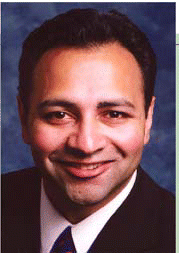TORONTO-Image-guided sinus (IGS) and skull base surgery is no longer considered experimental or investigational, and is appropriate for use by otolaryngologic surgeons to help clarify complex anatomy encountered during functional endoscopic sinus and skull base surgery (FESS). However, although it is a state-of-the-art approach, it is not in of itself the standard of care.
This was one of the messages from otolaryngologists who spoke at the panel Image-Guided Sinus Surgery: State of the Art at the recent annual meeting of the AAO-HNS. Topics discussed by panel members included standard of care, a description of the evolution of the technology, types of cases where IGS helps, and glimpses of a virtual endoscopic sinus surgery simulator.
When Should IGS Be Used?
When it comes to IGS, there are some cautions. You should not feel that navigation is mandatory in all your cases, and you should feel comfortable that standard of care is what you provide patients, and what you feel is safe, said Sanjay Parikh, MD, Assistant Professor of Otorhinolaryngology-Head and Neck Surgery and Pediatrics at the Albert Einstein College of Medicine in New York, who moderated the panel and presented a talk relating to IGS and standard of care.
Although few otolaryngologists used IGS only five or six years ago, the technology is commonly found in practice now, Dr. Parikh said. It is used to identify complex anatomy in procedures such as revision sinus surgery, distorted sinus surgery, extensive sino-nasal polyposis, surgery relating to disease that abuts the skull base, optic nerve or carotid artery, and more.
The AAO-HNS has guidelines and a position statement for the use of IGS; these show that the technology is no longer considered experimental.
There is sufficient expert consensus opinion and a literature evidence base to support its use. However, it’s impossible to corroborate this with level one evidence, Dr. Parikh said. Studies in the literature tend to be observational and are of small series of patients, meaning the evidence is weaker than that from randomized controlled trials.
However, the AAO-HNS endorses the intraoperative use of computer-aided surgery in appropriate select cases to assist the surgeon in clarifying complex anatomy during sinus and skull base surgery, he said.
IGS provides a number of advantages in that it can provide added safety, makes FESS easier since landmarks are better defined, and is something that patients may prefer.
At the same time, it is not the standard of care, he said. And standard of care is making sure to provide a level of care and skill that is considered acceptable and appropriate by the medical profession.
Surgeons should be familiar enough with the anatomy in routine cases that they don’t need IGS, or can continue surgery if the IGS system goes down, Dr. Parikh said. IGS shouldn’t be used unless necessary.


Leave a Reply